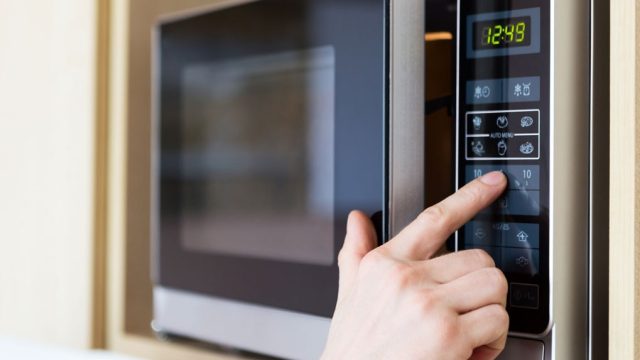This Is the Safest Way to Heat Food in a Microwave
A fast meal can be a healthy one with this microwave trick.

There are few things more convenient than popping food in the microwave and enjoying a perfectly-cooked meal mere minutes later. However, in recent years, the safety of nuking our food has come into question. The good news? It is possible to enjoy a healthy and safe meal cooked in the microwave.
To do this in the most safe and effective manner possible, you'll need four things: a thoroughly cleaned microwave, microwave-safe ceramic or glass container, a microwave-safe cover, and an eye on the clock. In your covered ceramic or glass dish, you'll want to heat your food at a medium to high temperature for the shortest amount of time necessary, stirring a few times during the heating process to integrate any hot spots.
While it may seem convenient to pop one of those plastic takeout containers right into the microwave, doing so could potentially harm your health. According to research published in Environmental Health, plastic products—even those that are BPA-free—can leach estrogenic chemicals into food, particularly when heated. And those that have already had a few spins in the microwave tend to be worse offenders when it comes to chemical contamination, according to researchers at Harvard. To limit your exposure to these potential hormone disruptors, use glass or microwave-safe ceramic dishes in the microwave instead. And, never, ever, ever put metal in the microwave unless you're eager to invite your local Fire Department over.
And while many people have beef with microwave cooking because they assume it's robbing their food of nutrients, those fears are likely unfounded. According to the Harvard Health Letter, microwaving is often preferable, because it uses the least amount of heat and time to cook food, preserving more nutrients in the process than methods like boiling or baking. Better yet, research published in Critical Reviews in Food Science and Nutrition reveals that microwave cooking had only minimal effects on the protein, fat, mineral, and vitamin content in food. In fact, researchers at Turkey's Selçuk University found that microwave-dried onions actually retained more of their cancer-fighting phenolic compounds when dried in a microwave versus those dried in the sun or oven. To preserve the most nutrients, use short bursts of medium to high heat, and use a microwave-safe lid to keep them moist and keep mess at bay. These BPA-free microwave-safe ceramic Corelle dishes fit the bill.
However, just because your food isn't being sapped of its nutrients doesn't mean your microwave is always a perfect environment for preparing food. One study conducted by Kimberly-Clark found that a shocking 48 percent of microwave handles had high levels of contamination, while another found E. coli bacteria lurking inside the microwave. So, as frequently as possible, give your microwave a wipe-down with a diluted vinegar solution. Laboratory tests reveal that vinegar containing just 0.1 percent acetic acid reduced the growth of all pathogenic bacteria.
Is your microwave probably safe to use? Yes. Heat up those leftovers to your heart's content. Use the right container in a clean microwave and you'll be just fine.
To discover more amazing secrets about living your best life, click here to sign up for our FREE daily newsletter!





















